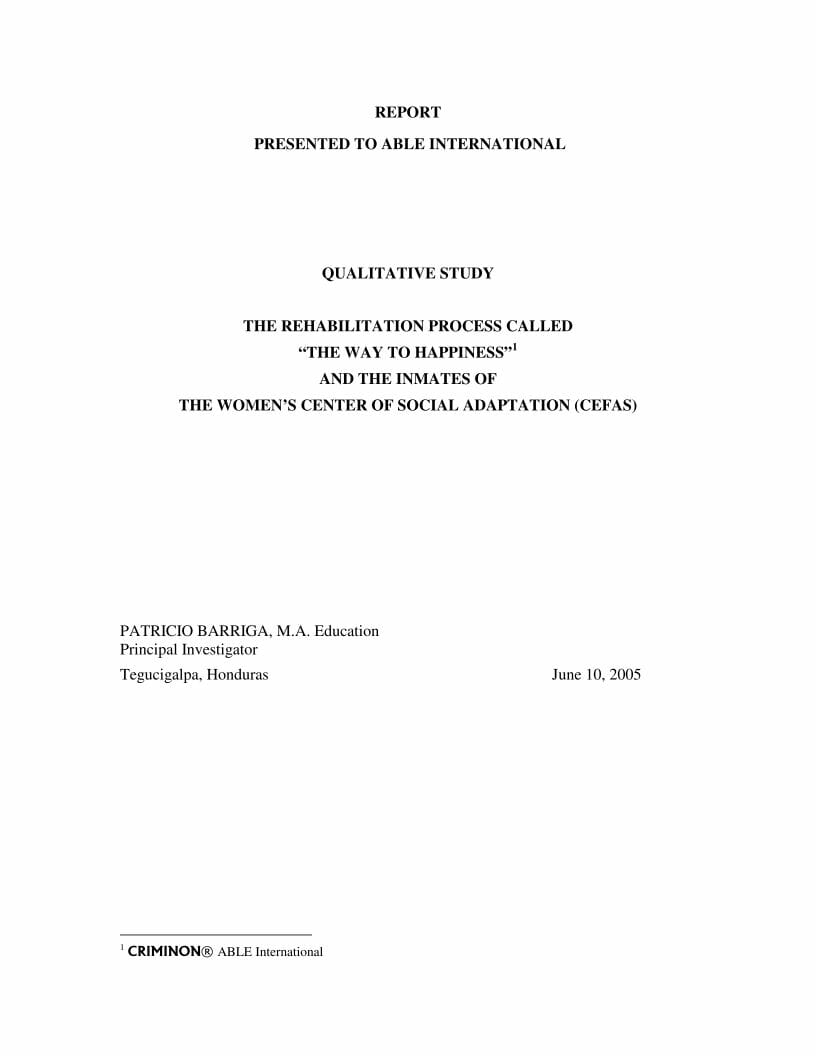Criminon in Honduras—The Womens Center of Social Adaption (CEFAS)
PATRICIO BARRIGA, M.A. Education
Principal Investigator
Tegucigalpa, Honduras
Principal Investigator
Tegucigalpa, Honduras
JUNE, 2005
Executive Summary:
This report focuses on the impact of the Criminon program intervention – a series of courses including, importantly, a life-skill course entitled, “The Way to Happiness”— on a group of women who are in a jail in Honduras, Central America, called the Women’s Center of Social Adaptation (CEFAS is its acronym in Spanish). The study is qualitative and uses an ethnographic methodology with in-depth focus groups and interviews. During the formulation and design of the study, it was found that this intervention is based on L. Ron Hubbard’s philosophy and technology expressed in his extensive bibliography covering the rehabilitation of individuals who have transgressed. His words, “But I will not admit that there is a naturally bad, evil man on Earth” illustrate the humanistic approach of the technology studied.
It was found that during the intervention in CEFAS, the Criminon program was custom designed and implemented in a manner to fit the inmates’ requirements for rehabilitation and the institutional circumstances. The intervention was flexible and adaptable to unforeseen incidents that took place in the detention center. The contents and procedures of the intervention had been previously established by Criminon; nevertheless, the people in charge of the process made decisions as they went along to give the contents and activities the greatest possible relevance and applicability. The study focused on the changes, both physical and emotional, that took place in the inmates due to this intervention.
In regards to Criminon’s methodology which was studied over a period of several months, the findings indicate that the rehabilitation process occurred in a relatively fast manner, through a dynamic balance between the following elements:
- Obtaining new data about the best ways to coexist with other human beings.
- Reflecting on their lives in the light of those data.
- Trying and adopting new behaviors.
In the literature read by the author of this report, it was found that L. Ron Hubbard emphasizes the importance of restoring self-respect in the criminal as the basis of his or her rehabilitation. He emphasizes that the person becomes a criminal when he stops respecting and trusting himself or herself. He says that when a person has reached that point, he or she is no longer willing to pay attention to his or her own actions, nor to consider their consequences.
It is considered that this is the reason that the processes studied here strongly emphasize the recovery of the person’s self-esteem. In other words, the individual who has transgressed, instead of being stigmatized for his or her crimes, receives help to regain his or her self-esteem. This process takes place through a series of exercises done in human relations workshops, which are combined with data about the rules of human coexistence which, predictably, many interviewed inmates had forgotten or had never known. In this way, they gradually improved their ability to trust themselves and others, in addition to improving their communication skills and learning, at the same time, to respect agreements and make decisions.
The Criminon rehabilitation process has various components which are done in sequence. First, a course on “learning how to learn” provides basic tools for use in study and effective ways to improve comprehension. Second, a course on basic rules about coexistence or getting along with others provides them with an ethical direction for behavior based upon an understanding of the advantages of acting in such a manner. The course, as well, includes many fundamental survival skills for daily life. Third, the women were involved in a production project which enabled them to work within the jail and feel productive. “When the person feels unproductive, his or her selfesteem decreases and he or she feels unproductive,” said the person who delivered the Criminon intervention. Fourth, the inmates actively participated in a communication workshop in which they not only improved their oral expression and human relationships skills, but also embarked on a process of knowing themselves better by utilizing tools known as “training routines.” These helped them to develop control of themselves and over their environment so as to better achieve the goals they had set for themselves in life. Finally, the intervention included a workshop to train some of the inmates in the skills and abilities needed to, themselves, deliver the program. This was done for the purpose of developing a number of inmates who could continue the Criminon intervention in the CEFAS. That is to say, this was a process of training of leaders, who developed the skills necessary to repeat and maintain the rehabilitation program in the Center.
The author noted that the effectiveness of this intervention was supported throughout 2003 and 2004 at the CEFAS in Honduras by guidance by the mother Criminon organization and its licensor, ABLE International.
The study found that the Criminon method is viable in Honduras, and therefore, it will likely be viable in any group of Spanish-speaking people. Accordingly, the Criminon methodology is recommended for application in other jails, prisons and penitentiaries


